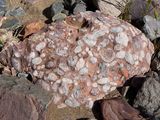what must be present in order for organic sedimentary rock to form.
Sedimentary rocks are formed on or about the Globe'southward surface, in contrast to metamorphic and igneous rocks, which are formed deep within the Globe. The nearly important geological processes that lead to the creation of sedimentary rocks are erosion, weathering, dissolution, precipitation, and lithification. Erosion and weathering include the effects of wind and rain, which slowly break down big rocks into smaller ones. Erosion and weathering transform boulders and even mountains into sediments, such every bit sand or mud. Dissolution is a form of weathering—chemical weathering. With this process, water that is slightly acidic slowly wears away stone. These three processes create the raw materials for new, sedimentary rocks. Precipitation and lithification are processes that build new rocks or minerals. Precipitation is the formation of rocks and minerals from chemicals that precipitate from water. For case, as a lake dries up over many thousands of years, it leaves behind mineral deposits; this is what happened in California'due south Death Valley. Finally, lithification is the process past which clay, sand, and other sediments on the bottom of the body of water or other bodies of water are slowly compacted into rocks from the weight of overlying sediments. Sedimentary rocks can be organized into two categories. The beginning is detrital rock, which comes from the erosion and accumulation of stone fragments, sediment, or other materials—categorized in total as detritus, or debris. The other is chemical rock, produced from the dissolution and precipitation of minerals. Detritus can be either organic or inorganic. Organic detrital rocks course when parts of plants and animals decay in the ground, leaving backside biological fabric that is compressed and becomes rock. Coal is a sedimentary stone formed over millions of years from compressed plants. Inorganic detrital rocks, on the other hand, are formed from broken up pieces of other rocks, not from living things. These rocks are often called clastic sedimentary rocks. 1 of the all-time-known clastic sedimentary rocks is sandstone. Sandstone is formed from layers of sandy sediment that is compacted and lithified. Chemical sedimentary rocks tin can be found in many places, from the ocean to deserts to caves. For example, near limestone forms at the bottom of the ocean from the precipitation of calcium carbonate and the remains of marine animals with shells. If limestone is found on land, it can be assumed that the expanse used to be under h2o. Cave formations are also sedimentary rocks, but they are produced very differently. Stalagmites and stalactites form when h2o passes through bedrock and picks upwards calcium and carbonate ions. When the chemical-rich water makes its fashion into a cave, the h2o evaporates and leaves behind calcium carbonate on the ceiling, forming a stalactite, or on the floor of the cave, creating a stalagmite.

An example of a sedimentary rock, which is, by definition, composed of many, smaller rocks.
Photo courtesy of Alamy Stock Photo
carbonate
adjective, noun
mineral created by the action of carbon dioxide on a base.
clastic sediment
Noun
rock equanimous of fragments of older rocks that have been transported from their identify of origin.
detrital stone
Substantive
sedimentary rock produced from small pieces of other rocks
dissolution
Noun
termination or destruction by breaking down, disrupting, or dispersing
Noun
act in which earth is worn away, oftentimes by water, wind, or ice.
geomorphology
Noun
study of geographic features on the landscape and the forces that create them.
halite
Noun
natural mineral form of salt (sodium chloride.) Besides chosen rock salt.
limestone
Noun
type of sedimentary rock more often than not made of calcium carbonate from shells and skeletons of marine organisms.
lithify
Verb
to change into stone or rock.
Noun
all forms in which water falls to World from the atmosphere.
Noun
solid material transported and deposited by water, ice, and air current.
shale
Noun
blazon of sedimentary rock.
stalactite
Noun
stone formed past mineral-rich water dripping from the roof of a cavern. The water drips, only the mineral remains like an icicle.
stalagmite
Noun
mineral eolith formed on a cavern floor, ordinarily by water dripping from to a higher place.
Noun
the breaking downward or dissolving of the Earth's surface rocks and minerals.
Source: https://www.nationalgeographic.org/encyclopedia/sedimentary-rock/#:~:text=The%20most%20important%20geological%20processes,large%20rocks%20into%20smaller%20ones.
0 Response to "what must be present in order for organic sedimentary rock to form."
Post a Comment